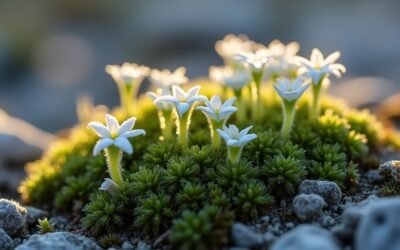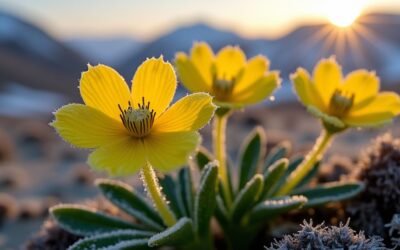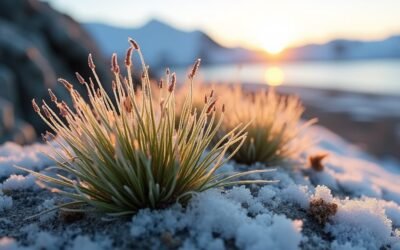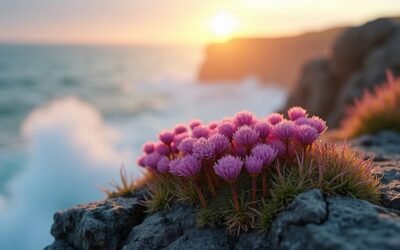Welcome to Arctic Wildlife Knowledge
Discover the wonders of the North: Your complete guide to Arctic life – uncovering the secrets of wildlife, vegetation, and climate in Earth’s frozen frontier

DID YOU KNOW?
The Arctic Region harbours over 21,000 identified species, including mammals, birds, fish, invertebrates, plants, fungi, and microorganisms, all adapted to thrive in extremely cold environments.

DID YOU KNOW?
The Arctic Ocean is the smallest and shallowest of the world’s five major oceans. It spans an area of approximately 14,060,000 km2 (5,430,000 sq mi)

DID YOU KNOW?
The Arctic is home to the Northern Lights, also known as the Aurora Borealis. This natural light display is a mesmerizing phenomenon caused by the interaction between charged particles from the Sun and the Earth’s magnetic field and atmosphere.

Learn With Us
Here at Arctic Wildlife Knowledge, we’ve created what one might call a digital sanctuary of understanding. A place where the mysteries of the North unfold before your eyes. Whether you’re curious about the remarkable hunting strategies of the Snowy Owl, the delicate beauty of Arctic Cotton Grass dancing in the midnight sun, or indeed the complex relationships between climate, ice formation, and the survival of species – you’ll find it all here, meticulously documented and lovingly shared.
Our experiences – tracking polar bears across the sea ice, observing the spectacular Aurora Borealis paint the sky, and documenting the brief but explosive abundance of Arctic summer life – have given us a profound understanding of this remarkable ecosystem. We’ve collaborated with indigenous communities, worked alongside leading scientists, and witnessed first-hand the dramatic changes occurring in this sensitive region of our world.
Latest News From The Blog
Don’t Miss A Thing
Snow Pearlwort (Sagina Nivalis)
In the harshest Arctic conditions, this tiny but tenacious plant reveals remarkable survival secrets that could revolutionize our understanding of cold adaptation.
Snow Gentian (Gentiana Nivalis)
Learn how this tiny blue alpine wonder survives extreme mountain conditions and temperatures as low as -25°C.
Snow Fleabane (Erigeron Uniflorus)
Mountain-dwelling snow fleabane thrives in extreme alpine conditions, but its incredible survival secrets will leave you amazed.
Snow Buttercup (Ranunculus Nivalis)
Under Arctic skies, the resilient Snow Buttercup defies extreme cold with remarkable adaptations that unlock nature’s secrets to survival.
Sedges (Carex)
From triangular stems to remarkable cold tolerance, sedges showcase nature’s engineering while quietly safeguarding soils across diverse global habitats.
Sea Thrift (Armeria Maritima)
Coastal gem Sea Thrift dazzles with pink blooms and incredible survival skills, but its most astonishing adaptation remains hidden beneath.
Saxifrage (Saxifraga Caespitosa)
Native to the Arctic, this resilient “stone-breaker” plant survives extreme cold by producing remarkable antifreeze proteins in its tiny leaves.
Rosa Acicularis (Tundra Rose)
Discover how this resilient Arctic rose survives bone-chilling temperatures while producing vitamin-rich fruits that sustain northern wildlife.
Reindeer Lichen (Cladonia Rangiferina)
Learn how this resilient arctic lichen survives extreme cold, feeds wildlife, and shapes northern ecosystems in remarkable ways.
Purple Saxifrage (Saxifraga Oppositifolia)
Overlooking Arctic tundra, this resilient purple flower breaks through frozen rock and snow, revealing nature’s remarkable secrets for survival.
Purple Fireweed (Chamaenerion Latifolium)
Purple Fireweed dominates post-fire landscapes with vibrant magenta blooms, but its remarkable survival tactics hold an even more fascinating story.
Polar Grass (Arctagrostis Latifolia)
Observe how this Arctic survivor thrives at -40°C through remarkable adaptations that revolutionize our understanding of cold-resistant plants.
FAQ
Frequently Asked Questions
What makes Arctic Wildlife Knowledge different from other wildlife websites?
Our website combines first-hand experience, scientific accuracy, and comprehensive coverage of the entire Arctic ecosystem – from wildlife and plants to climate patterns – all in one accessible location.
How current is your information?
We regularly update our content to reflect our latest findings, environmental changes, and our ongoing expeditions to the Arctic region.
Who creates your content?
Our team consists of experienced Arctic explorers who have spent decades studying and documenting Arctic ecosystems.
Can I use your information for educational purposes?
Yes! We encourage educational use of our materials, with proper attribution.
Do you provide information about visiting the Arctic?
We offer comprehensive guides about responsible wildlife viewing, best seasons for observation, and important safety considerations.
How do you gather your information?
Through regular Arctic expeditions and continuous field observations throughout the year.
Do you cover conservation issues?
Absolutely. We provide up-to-date information about conservation challenges, climate change impacts, and ways to support Arctic preservation efforts.
How do you ensure accuracy?
Our content is based on careful research and our own documented observations in the field.
What regions do you cover?
We cover the entire Arctic circle, including Svalbard, Northern Canada, Greenland, Alaska, and the Russian Arctic regions.
How often do you add new content?
We publish new articles weekly, with major updates to existing content monthly.
What kind of wildlife do you feature?
We cover all Arctic species from the largest mammals like polar bears to the smallest plants and insects, providing comprehensive information about their behaviors, habitats, and survival strategies.
What makes your content reliable?
Our information comes from direct observation and decades of combined experience studying Arctic ecosystems.












